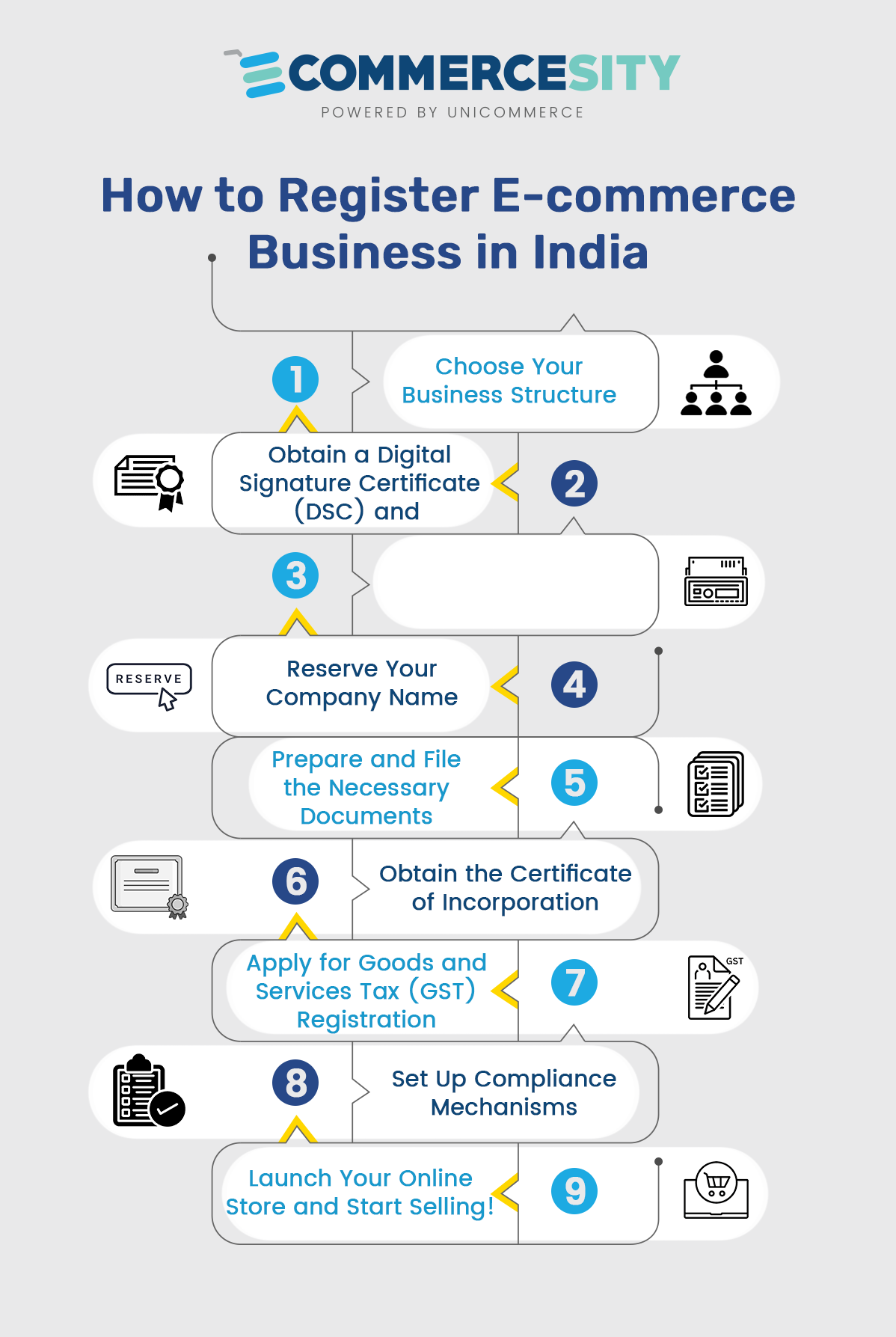India is a bustling e-commerce landscape, and everyone is taking a swing at it with their creativity and ideas as they try to break into the market. It has become one of the fastest-growing industries in India. In this growing digital landscape, emerging Indian brands offer various products, from pickles to apparel, perfumes, and handicrafts.
As e-commerce thrives in India, traditional retail stores face challenges. Many consumers now prefer the convenience of online shopping, which is why many retailers are establishing themselves digitally. To compete, traditional retailers adapt by establishing their online presence or implementing omnichannel strategies to provide a seamless online and offline shopping experience.
If you are ready to plunge into the online business, it is not just about setting up a shop with products and a great website. When you dive into the details, you need to navigate through the process of company registration.
How to Register E-commerce Company in India
Here are the steps to follow while registering your e-commerce business:

Step 1: Choose Your Business Structure
Before starting the process, you must know your venture’s most suitable business structure. In India, you can go for a sole proprietorship, partnership limited liability partnership (LLP), private limited company, or a one-person company (OPC). Each business structure has its legal implications and tax benefits, so you must identify your business structure aligning with its goals and objectives.
Step 2: Obtain a Digital Signature Certificate (DSC) and Director Identification Number (DIN)
To kickstart registration, you must acquire a Digital Signature Certificate and Director Identification Number (DIN). The DSC is essential for signing documents digitally, while the DIN is a unique identifier for directors. These can be obtained through authorized agencies or online portals approved by the Ministry of Corporate Affairs.
DSC and DIN are crucial requirements to ensure the authenticity and accountability of directors during the registration process. The DSC enables secure digital signatures, while the DIN serves as a unique identification for directors, streamlining the registration process and ensuring compliance with regulatory guidelines.
Step 3: Reserve your Company Name
Choosing the company’s name is a crucial and thoughtful step. One must ensure that the company’s name reflects your brand and appeals to the consumer. Another essential thing to remember is to ensure that another entity is not already using the chosen brand name. Use the Ministry of Corporate Affairs (MCA) online portal to check for name availability and reserve it before someone else beats you!
Step 4: Prepare and File the Necessary Documents
Filing documents and doing necessary paperwork is an essential aspect of registration. You finalize your company and move ahead with its establishment through this process. Documents include a Memorandum of Association (MOA), Articles of Association (AOA), identity and address proofs of directors and address proof for the registered office. Once ready, apply for incorporation and the requisite fees with the Registrar of Companies (ROC) through the MCA portal.
Step 5: Obtain the Certificate of Incorporation
Once you have submitted your application for your registration, sit tight while it undergoes verification by the ROC. If all goes well, you will receive a coveted Certificate of Incorporation, signaling the official birth of your e-commerce company. Congratulations, you’re now a bona fide player in the digital marketplace!
Step 6: Apply for Goods and Services Tax (GST) Registration
Once you register as a seller in India. You must operate legally and register for Goods and Services Tax (GST). To register for GST, visit the GST portal and complete the registration process by providing the necessary information about your business.
Step 7: Set Up Compliance Mechanisms
Compliance is not limited to registration. Follow the laws and regulations by adhering to ongoing regulatory requirements, such as filing annual returns, maintaining financial records, and fulfilling tax obligations. Compliance also requires regular review of policies and procedures to ensure they are up to date and in line with current regulations. Additionally, it is essential to provide training on compliance to all employees to ensure that they are aware of and comply with the rules.
Step 8: Launch Online Store and Start Selling!
Congratulations on taking the steps to launch your e-commerce venture! With all the legal formalities squared away, it’s time to get your online store up and running. Remember to remember your customer’s needs as you showcase your products or services.
It’s essential to offer a seamless user experience that is easy to navigate and satisfies your customer’s needs. Remember to keep your website up-to-date and make improvements as necessary to ensure that your customers keep coming back.
Registration of an e-commerce company in India may seem tedious, but with the proper guidance and determination, the goal is not very far. But where can you get that guidance from? Knock on Ecommercesity’s door!
Ecommercesity is your way to learn and leverage the idea of building an e-commerce business. Our certification provides insights on how to become a successful entrepreneur in the vibrant Indian e-commerce landscape. With this industry-dedicated and nuanced course module, you can learn how to register your brand and grow it with the techniques and skills required in the industry.
Remember, the journey is long, but you can grab onto it and walk the path effortlessly. So, take that first step today, join Ecommercesity, and embark on the exhilarating adventure of entrepreneurship!
Happy selling!
Top Courses in E-commerce Operational Excellence –

